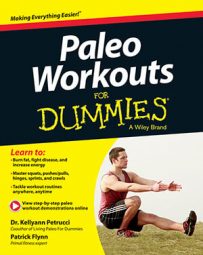The cave man was perhaps a perfect role model for health and exercise because he didn’t try to improve something that was virtually faultless. He followed his genetic programming: He moved how he was meant to move and ate how he was meant to eat. He was fit and healthy.
In the domain of exercise today, fads come (and just as often go) like pimples on a teenybopper. Most of these crazes are, at best, useless, but quite a few have even grown to be dangerous. One concern lies in not only poor movement but also the gross lack of desire, or priority, for strong, beautiful movement.
Only a handful of popular fitness practices approach exercise this way. Most make people move but fail to first show them how to do so. Many fitness programs make the conventional assumption that people just know how to move, or that they know how to move well. However, for most, quality movement is like writing cursive — an elegant skill that gets sloppy without practice.
Too many people don’t give enough respect to strong, beautiful movement. Although most conventional fitness fashions neglect strength and movement quality, they do serve a hidden but useful purpose: They remind people of the values of paleo fitness.
These values help you achieve a leaner, harder, and more resilient physique. Understand that many of these principles directly contradict conventional fitness practices — that’s the point.
Conditioning yourself for something other than exercise
The first principle of Paleo fitness states that the most basic and appropriate function of exercise should be to condition someone for something other than exercise. Whether that something is a sport is of small significance. Exercise is, and should remain, a means (a method) to an end (a goal), but many conventional fitness practices forget this detail, because they take the means (exercise) and make it an ends (a sport or competition).
Exercise should be a means to health. Exercise should promote health and vitality — and never, under any circumstance, should it ever detract from that. When that is covered, you may then explore exercise as a means to other ends, such as for spiritual purposes or athletic enhancement.
The harm comes when people turn exercise into a competitive sport. Quality is swapped for quantity, and people get hurt. Exercise should make you better at all things, at all times, and in every way. Anything else simply won’t do.
Getting just the right amount of exercise
The second principle of Paleo fitness states that exercise is best served in small to moderate doses, which is to say just enough to get the job done and not a smidgeon more. But again, conventional practices overlook this detail, made clear by the number of people who spend hours every day trudging on treadmills and spinning on bicycles.
Practices that create a chronic state of stress on the body are ill suited for sustainable bodily profits, not to mention wholly ineffective for long-term weight loss. Again, exercise should make you better at all things, at all times, and in every way.
Now the “right” amount of exercise is entirely relative and subjective, but in most cases, it’s probably a lot less than you think.
Promoting beautiful movement
The third principle of Paleo fitness states that exercise should promote beautiful movement and stimulate a positive hormonal response.
Just as trudging on the treadmill is equal to committing biomechanical treason so is crushing yourself day in and day out by lifting weights. One promotes a dysfunctional movement pattern (gait) and the other a negative long-term hormonal response (overtraining). But conventional fitness practices manage to overlook this detail, as big-box gyms pummel the masses with a less than choice exercise selection. Injury rates are high and retention low. Go figure.
With Paleo fitness, you marry beautiful movement with beautiful food, which results in a strong, beautiful body.
Keeping it simple: The secret to a good fitness program
Any exercise (and nutrition) program will improve in direct proportion to the number of things that you can keep out of it that don’t need to be there. In other words, the secret to a good exercise program is to strip it down to the fewest possible parts — the fundamentals — and leave it at that. Paleo fitness is all about simplicity.
The fundamentals of Paleo are simple and proven effective. All you have to do is follow a simple diet of meats, eggs, fish, veggies, nuts, seeds, and some fruit. Then move often and move beautifully, lift heavy every couple of days, and occasionally run for your life (just not on a treadmill).
The secret is to practice strength selectively. About 20 tried-and-true exercises — which probably amounts to less than 5 percent of all the exercises out there — are guaranteed to get you 95 percent of all the results you could ever want.
And just as you carefully choose how to move, be selective in what you eat, too. You need to eat less — not necessarily fewer calories but less variety and less frequently. Eat the same Paleo foods often, but eat them infrequently.
When it comes to fitness, “all change is decay.” Keep it simple with the fundamentals, and you’ll do all right.

